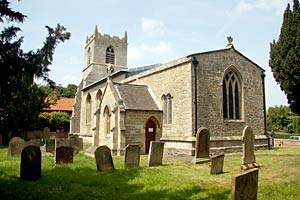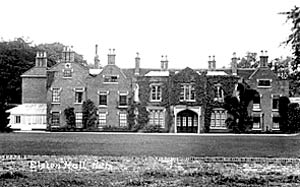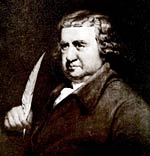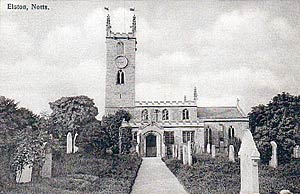< Previous | Contents | Next >
The Three Bells

Elkesley church in 2013.
© Copyright Richard Croft and licensed for reuse under this Creative Commons Licence
ELKESLEY. There is money in Elkesley belfry where three old friends keep company, and beauty all round this village of the old Sherwood Forest, lying between the lovely park of Clumber and the open country stretching to the Trent.
Its own beauty spot is by Twyford Bridge, where rivers meet and four roads converge. Here the little River Poulter comes its lovely way from Clumber, flowing under the road to find the waters of the Meden and the Maun and going on as the Idle. Here a charming road, like a grass-bordered avenue of sturdy limes, sets off to Ollerton.
The lofty 14th century tower serves as a porch with two doorways. One is 15th century, and in it hangs a fine panelled door of 1612. We come, to its north doorway under an arch which is part of the 15th century nave arcade, left outside when the aisle was shortened. It is remarkable to discover that three of the bells have been ringing in this tower for 500 years, two of them inscribed, "I have the name of Gabriel who was sent from Heaven," and "This bell sounds for the praise of Holy Mary," and between the words are coins of their day.
The church was partly rebuilt last century, but it has some 15th century windows (including the clerestory) and a 14th century east window. The old nave roof has two bosses, and between the nave and chancel is an embattled beam. The chancel has no arch; near its entrance is an old niche, and above this is another niche which is the old rood-stair doorway with a new top. There is a Jacobean table, and a massive old oak bench like a glorified settle is crowded with carving. The small bowl of the old font has been set on a queer modern pedestal, after being used as a pump trough. The comical face of a man looks out from the nave arcade, and the quaint face of another smiles between two windows outside.
Darwin the First

Elston Hall, c.1920.
ELSTON. Hidden from the Fosse Way by a great belt of trees is this charming village, where a windmill like a black giant still grinds the corn. Near a meeting of the ways where fine trees make vaulted arches in three directions stands the long grey hall, famous as the birthplace of great men; its lawns come to the edge of a low wall crowned by vases of flowers, and a splendid cedar, seen from the gate, stretches out its arms like a huge candelabra.
The house has grown up and been modernised while it has been the home of the Darwins from the 17th century. Here came William Darwin from Lincolnshire when he married the heiress of the Warings; and here to his son Robert (in whom began to develop the love of science which was to make the name a household word) were born two sons, Robert (who wrote the Principia Botanica), and Erasmus the physician, poet, inventor, and scientist.

Erasmus Darwin (1731-1802).
Born in 1731, Erasmus had a successful career as a doctor in Lichfield. He won a reputation as a poet, and showed his love of living creatures in his Loves of the Plants (one of two parts of his Botanic Garden) in which he foretold steam locomotion and even the flying machine in these remarkable words:
Soon shall thy arm, Unconquered Steam, afar
Drag the slow barge or drive the rapid car;
Or on wide-waving wings expanded bear
The flying chariot through the fields of air.
He had wonderful powers of observation, and his mind teemed with far-reaching and potential ideas. He invented and suggested many domestic and industrial machines, and was a pioneer in sanitary reform as well as a great advocate of temperance in drinking. We remember him best for his anticipation of the theory of evolution, and for being, through his two marriages, the grandfather of the famous Charles Darwin and of Francis Galton. He spent his last years at Breadsall Priory in Derbyshire, and has been sleeping in Breadsall church since 1802.
The almshouses founded by Ann Darwin nearly two centuries ago are facing the church, which has four tiers of battlements and a slender tower with elaborate pinnacles. Beyond a row of yews is the grey stone rectory, gabled and stately, with flowers in fine array, and a splendid cedar on its lawn.

Elston church, c.1910.
Though the church is much restored, the two lower stages of the tower are 13th century, the time of three lovely windows in the chancel which have foliage capitals crowning their shafts. The tiny font may be 600 years old. Among the Darwin memorials is one to the father of Erasmus.
In the lower part of the village is an ancient chapel standing in a field beyond a cluster of farms and cottages. Unused but cared-for, it has a lovely Norman doorway adorned with zigzag, two great 13th century buttresses, two 14th century windows, part of a coffin stone in a wall, and a pulpit with Jacobean carved panels.
